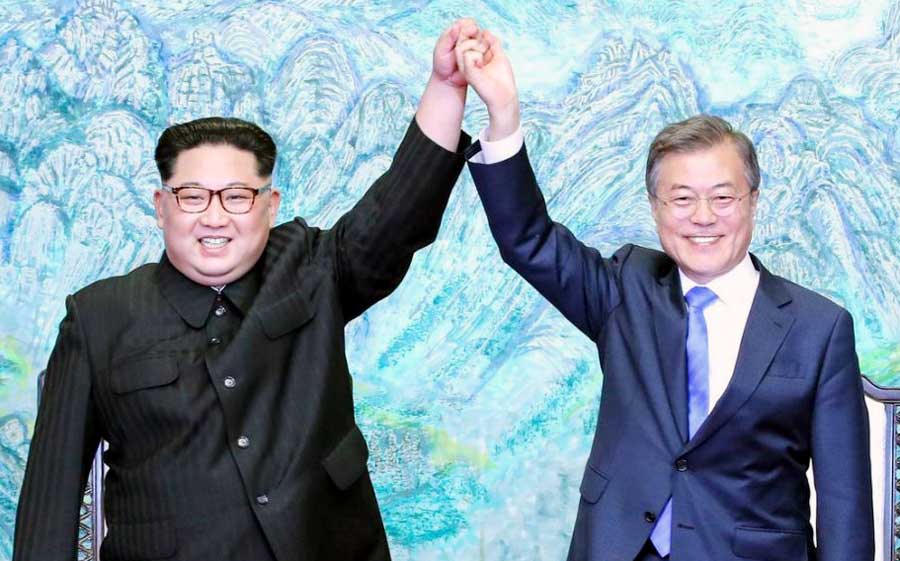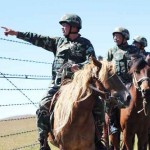While the Indian media was busy covering the historical informal summit meeting between Prime Minister Modi and Chinese President Xi Jinping at Wuhan in Central China, another path breaking event was taking place in the nearby Korean Peninsula. For the first time, after 65 years, a North Korean Ruler entered South Korea in pursuit of peace for a summit meeting with South Korean President Moon Jae in.
Incidentally, this was only the second time that North Korean Supremo Kim Jong-un was meeting any head of a state ever since he assumed control in 2011 after the death of his father Kim Jong- il. The first meeting was held only a few weeks earlier when his train chugged into China for a secret meeting with the Chinese President Xi Jinping, an event that was made public 48 hours after it took place.
The recent meeting of Kim with the South Korean head of state is being interpreted by many as a precursor for the much publicised summit meeting Kim is going to hold with POTUS Trump sometimes towards end of May or early June.
Not very long ago, the Korean Peninsula had become a nuclear flash point and the media was agog with the speculations of a Third World War. Tensions were so high that there was a constant twitter war between Kim and President Trump, each calling each other names and threatening to blow off the rival countries.
North Korea, ignoring the international pressure, continued on its path of nuclearisation and also claimed to have tested a Hydrogen Bomb somewhere in the pacific. It launched on a project of testing a number of Intermediate Range Ballistic Missiles (IRBM) and finally claimed to have tested an Inter-Continental Ballistic Missile (ICBM) that could hit any city in American mainland. This was the height of arrogance as both US and China had warned Kim to not to pursue his nuclear agenda and abandon the same. The Korean Peninsula was on fire. Even, Japan warned North Korea of severe consequences but to no avail.
Many thought that Kim was digging his own grave because he was living in a constant fear of a coup or elimination. India also expressed its concerns because she was more worried about the proliferation of the Korean missiles into the hands of her arc enemy Pakistan. Russia almost remained a mute spectator enjoying the ringside view giving an impression that it gave clandestine support to the Korean despot.
Kim’s insistence to not to halt his programme till it achieved nuclear parity with USA. UN sponsored international sanctions appeared to have no effect on Kim. The internal situation in North Korea was turning from bad to worse, there was acute shortage of everything, and restrictions were laid on consumption of liquor and celebrations. The controlled Korean media fed the North Koreans fabricated stories including superstitious statements to make them believe that USA will eliminate North Korea until their President Kim is able to develop nuclear capability to match that of USA.
China, an ally of Korea, also came forward to cooperate with the international community and tightened the screws on North Korea through strict enforcement of economic sanctions. All international flights to North Korea were initially curtailed then cancelled. The entire economic aid dried up and isolation of North Korea was complete. It goes to the credit of Kim that despite total international isolation he did not compromise the pursuit of his nation’s nuclear strategy.
The North Korean nuclear strategy is two-pronged. The first prong envisaged development of nuclear deterrence so that North Korea could not be black mailed by any rival power. The second prong envisages using deterrence as a leverage to develop friendly relations with international community particularly with USA and work for peace, prosperity and reunification in Korean Peninsula. Contrary to the popular belief it is the second prong of nation’s nuclear strategy that has led to the change in heart of Kim and NOT the international sanctions. He withstood the international sanctions and yet achieved the first prong of the nuclear strategy that is nuclear deterrence.
It is, therefore, pursuit of peace and prosperity that has made Kim take that historic step of breaking the barriers and stepping into South Korean territory for a summit meeting. Kim is not only a despot but a shrewd thinker as well. He, therefore, holding each other’s arm, made President May to step into North Korean territory as well signalling that they both were willing to walk miles together for ushering an era of peace in the Korean Peninsula and convert the demilitarised zone (DMZ) into a Zone of Peace.
The two leaders appeared to be very sincere in their desire for peace and reunification. Sceptics quote the earlier failed efforts in 2007 and 2010 to not get over board with the current initiative. However, the strategic scenario has changed ever since then with North Korea acquiring Nuclear Deterrence and Kim is seen to be pursuing a well- planned strategy. The two leaders have announced a slew of confidence building measures (CBMs) that plan to bring the two Koreas closer leading to ultimate reunification. They have announced their desire to sign a Treaty of Peace later this year bringing an end to virtual state of war that exists between the two ever since 1950-53 Korean War.
“I feel that we are part of one family and both countries will have a new policy of cooperation. After years of disputes, we are here today to say that nothing will make us different again,” said Kim.”Kim Jong-un and I declare that there will be no more war on the Korean Peninsula and a new age of peace has begun,” responded Moon.
Much will depend on the outcome of the Kim-Trump summit meeting due next month. “The United States in the past was played like a fiddle,” by North Korea, because Pyongyang could take advantage of a “different kind of leader,” Trump said boastingly. “That’s not happening to us.”Trump boasts he has forced the issue through his tough stance on North Korea during his first year in office, and vowed that he will be a sharper negotiator than any of his predecessors. Trump also credits the personal bond he forged with Chinese President Xi Jinping for fostering the rapid turnabout with North Korea, China’s Communist ally and economic lifeline. It will be too early to be judgemental and ascribe reasons of the sudden change of heart that has led Kim to become a messiah of peace from a despotic war-monger?
Pyongyang has proven an unreliable negotiator in the past; a failure of talks now could inflame tensions back to where they were only months ago, when there were concerns that a military confrontation was becoming more likely. Whether it is Trump-effect or pursuit of nation’s nuclear strategy by Kim, will be known only after the two meet?
As on date, there appears to be no common definition of ‘denuclearisation’ between the two countries. While President Trump is likely to insist on dismantling the complete nuclear assets held by North Korea, the latter is going to resist the same because it is against the nation’s nuclear strategy. Kim is going to insist on ‘capping’ the assets and no further nuclearisation. How much egoistic Trump will be willing to concede will determine the future course of events in the Korean peninsula?
Kim has already announced destruction of his nuclear site and announced no more launching of ballistic missiles. The two Korean leaders are keen on peace returning to the Korean peninsula but will they be able to convince USA? The international community, particularly the major powers in the area, China and Russia are also keen for peace but their view on reunification is still ambiguous. Is China willing to accept a unified Korea in its immediate neighbourhood?
Will Trump also agree to remove the nuclear assets from South Korea and Japan? Is USA willing to revisit the Treaty of San Francisco? Will Japan be allowed to build its own armed forces? There is going to be a conflict between the strategic interests of USA, China and aspiration of regional unification as far as the two Koreas are concerned. Will the existing line (DMZ) continue or become a part of history heralding a new era of peace and prosperity in the Korean peninsula cannot be decided by the two Koreas themselves but has many other stakeholders.
India, rightfully, favours peace in the region. Though India would also like complete denuclearisation in the peninsula, it would not mind even if ‘capping’ takes place as long as India’s concern of nuclear proliferation emanating from North Korea and landing in our neighbourhood is addressed properly. “India supports all efforts to bring about peace and stability in the Korean peninsula through dialogue and diplomacy,” according to MEA spokesperson Ravish Kumar. “We hope that such engagement will help in reducing tensions and pave the way for lasting peace and reconciliation in the Korean peninsula,” he added.





